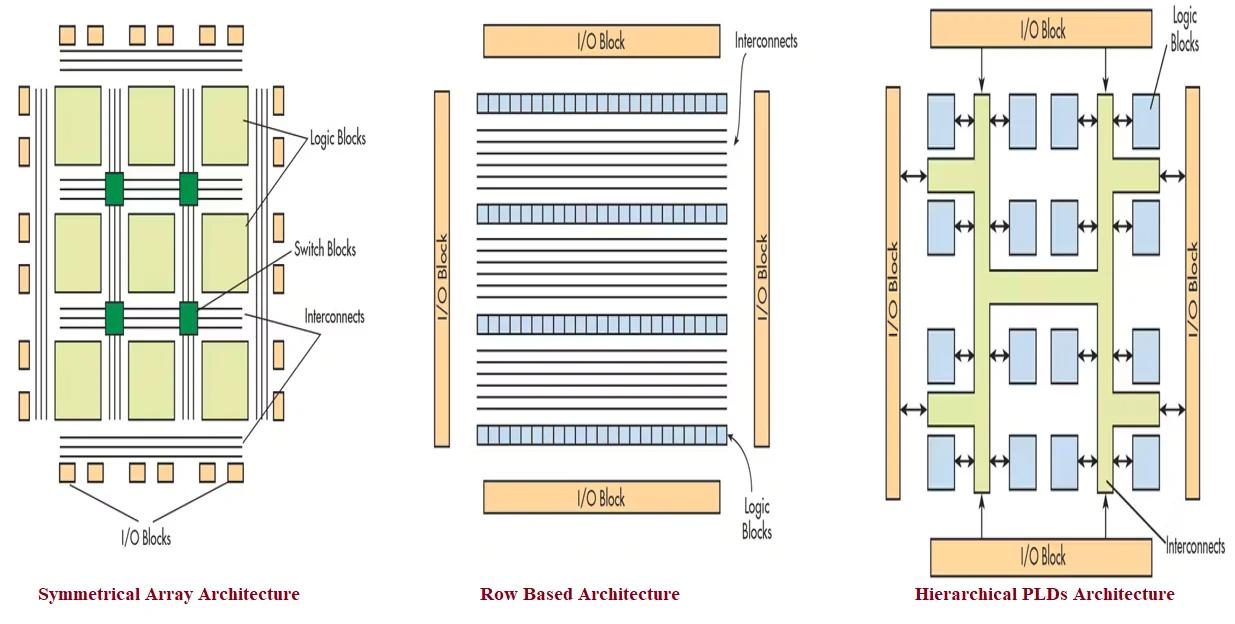Types of FPGA : Key Differences, Advantages, Disadvantages
Advertisement
FPGAs are semiconductor devices containing an array of programmable logic blocks, interconnects, and configurable I/O blocks. Users or designers can reprogram these devices to implement different digital logic functions. FPGAs are widely used in various applications, including prototyping, signal processing, telecommunications, and embedded systems.
FPGAs can be categorized based on various factors, each influencing the device’s capabilities, performance, and use cases. The main factors for categorizing different types of FPGA are their architecture, logic density, power consumption, application focus, package type, and additional resources.
Architecture Based Categorization
1. Symmetrical Arrays
This refers to FPGA architectures where the logic and routing resources are arranged in a symmetrical or regular grid pattern. In a symmetrical array, each logic block is surrounded by an equal number of routing channels on all sides.
Advantages:
- Simplifies the design and routing process due to the regular structure.
- Offers uniformity, making it easier to predict and control signal delays.
Disadvantages:
- May not be as efficient for certain irregular or asymmetrical designs.
- Can result in underutilization of resources in some areas of the array.
2. Row-Based Architecture
In this FPGA architecture, the logic and routing resources are organized in rows across the FPGA. Each row typically contains a set of logic blocks and associated routing resources.
Advantages:
- Provides flexibility in connecting logic blocks within the same row.
- Simplifies the routing between neighboring logic elements in a row.
Disadvantages:
- May introduce longer inter-row routing delays.
- Can be less efficient for certain designs that require extensive horizontal connections.
3. Hierarchical PLDs
Hierarchical PLDs, also known as hierarchical FPGAs, feature a structure where smaller programmable logic blocks are organized into larger, more complex structures. These smaller blocks can be considered building blocks for constructing larger circuits.
Advantages:
- Facilitates modular design by breaking down a large circuit into manageable sub-blocks.
- Offers better organization and abstraction, making it easier to comprehend and manage complex designs.
Disadvantages:
- May introduce additional delays in signal propagation between hierarchical levels.
- The complexity of managing hierarchical designs may increase during the design process.

Configuration Memory-Based Categorization
1. SRAM-Based FPGAs
These FPGAs use static random-access memory (SRAM) cells to store the configuration data. The configuration can be modified on-the-fly, making them reprogrammable.
Advantages:
- Flexibility and ease of reprogramming, suitable for prototyping and development cycles.
Disadvantages:
- Configuration data is volatile, requiring reprogramming each time the device is powered on.
2. Antifuse-Based FPGAs
Antifuse-based FPGAs use antifuse elements to permanently configure the device. Once programmed, the configuration is non-volatile.
Advantages:
- Lower power consumption, greater security, and resistance to reverse engineering.
Disadvantages:
- Limited reprogramming capability compared to SRAM-based FPGAs.
3. Flash-Based FPGAs
These FPGAs use flash memory cells to store configuration data. They offer a balance between reprogrammability and non-volatility.
Advantages:
- Non-volatile configuration, with some reprogramming capability.
- Suitable for applications where power-on configuration changes are not frequent.
Disadvantages:
- Limited endurance compared to other non-volatile technologies.
Feature-Based Categorization
1. Heterogeneous FPGAs
These FPGAs incorporate additional specialized processing elements alongside traditional FPGA fabric. This can include embedded processors, DSP blocks, or other specialized hardware.
Advantages:
- Enhanced performance for specific tasks, such as signal processing or machine learning, through dedicated hardware blocks.
Disadvantages:
- Increased complexity and potential for higher power consumption.
2. 3D FPGAs
These FPGAs stack multiple FPGA layers on top of each other, connected with through-silicon vias (TSVs). This vertical integration increases logic density and can improve performance.
Advantages:
- Higher logic density, potentially improved performance, and reduced interconnect delays.
Disadvantages:
- Increased complexity and manufacturing challenges.
Capacity-Based Categorization
1. Logic Density Based FPGAs
- Low-Capacity FPGAs: These FPGAs are designed for simpler designs with lower logic requirements.
- Mid-Range FPGAs: Suitable for moderate complexity designs with a balanced mix of logic elements and resources.
- High-Capacity FPGAs: These FPGAs have a larger logic capacity and are capable of handling complex designs with a high number of logic elements and embedded resources.
2. Power Consumption Based FPGAs
- Low-Power FPGAs: Designed with a focus on minimizing power consumption, making them suitable for battery-operated or power-sensitive applications.
- Standard Power FPGAs: Typical power consumption FPGAs for a broad range of applications.
- High-Performance FPGAs: These FPGAs may have higher power consumption to achieve maximum performance.
Application-Based Categorization
- Communications FPGAs: Optimized for communication and networking applications.
- Signal Processing FPGAs: Designed for applications requiring intensive signal processing tasks.
- Embedded FPGAs (eFPGAs): Integrated into SoCs (System-on-Chips) and suitable for on-chip programmable logic.
Other FPGA Types
- Package Type: Ball Grid Array (BGA), Quad Flat Package (QFP), etc.: Different packaging options based on the application’s size, form factor, and mounting requirements.
- Clocking Architecture:
- Low-Clock FPGAs: Designed for applications with lower clock speeds.
- High-Performance Clocking FPGAs: Optimized for high clock frequencies and performance-critical applications.
- Memory Resources: FPGAs with High On-Chip Memory: Suitable for applications that require significant on-chip memory resources.
Conclusion
In summary, categorizing FPGAs into different types allows designers to choose devices that best match their specific application requirements, balancing factors such as logic capacity, power consumption, and performance. The choice depends on the target application, design complexity, and the need for specific features or optimizations.
Advertisement
 RF
RF


